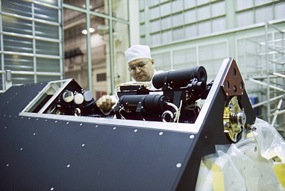A Hubble Space Telescope original returns to Wisconsin
After a journey of some 535 million space miles, give or take, and years languishing in a cavernous government warehouse, one of the original scientific instruments aboard the Hubble Space Telescope has splashed down in Wisconsin.
The High Speed Photometer or HSP was one of five interchangeable instruments aboard the telescope when it first soared into orbit aboard the Space Shuttle Discovery in April 1990. Developed at the University of Wisconsin–Madison’s Space Astronomy Laboratory and the Space Science and Engineering Center, HSP was the only element of the groundbreaking $6 billion space telescope built by a university.
“We’re glad to get it back,” says Robert C. Bless, the UW–Madison astronomer whose team designed and built the 600-pound telephone booth-sized photometer. “NASA has a knack for losing things.”
The well-traveled device will land at UW–Madison’s Space Place, the university’s astronomy outreach outpost on Madison’s south side beginning this Friday (July 20) with the opening of a new exhibit. It will be on display with other Wisconsin-built instruments and telescopes that chronicle the history of space astronomy at UW–Madison dating to the 1950s, according to Jim Lattis, Space Place director.
As its name implies, HSP was like a high-end light meter. It could sample the changing brightness of stars and other celestial objects at a rate of 100,000 times per second, providing insight on everything from pulsars to planetary ring systems. “No self-respecting observatory should be without a photometer, and we originally proposed an add-on, something about the size of two thermos bottles and a shoe box,” recalls Bless, now an emeritus professor of astronomy. “But NASA liked the idea and asked for a full-fledged instrument.”

Prior to its integration into the Hubble Space Telescope, a technician adjusts the High Speed Photometer (HSP), one of the telescope’s original scientific instruments. As its name implies, the device worked like a souped-up light meter and was capable of sampling starlight at a rate of 100,000 times per second. Built by scientists and engineers at UW–Madison Space Astronomy Lab and Space Science and Engineering Center, HSP was the only element of the giant orbiting telescope to be built by a university. It was removed from Hubble in 1993 and replaced by the optics package needed to correct the images blurred by the telescope’s misshapen mirror.
HSP was the essence of simplicity. It had no moving parts, depending instead on the Hubble Telescope itself to route starlight through its tiny apertures. “It was an elegant scientific instrument that performed flawlessly on orbit,” notes Fred Best, a UW–Madison Space Science and Engineering Center engineer who led the mechanical and optomechanical design of HSP. “There could be nothing built in that could bend, twist or break.”
Sadly, the full capability of the Wisconsin instrument was never realized because of the combination of the flawed Hubble mirror and a case of the jitters caused by excessive flexing of the orbiting observatory’s original solar panels.
Thus, the full complement of science Bless and others hoped to conduct using HSP never truly came to fruition: “It’s a shame things turned out the way they did,” says Jeff Percival, a senior scientist at the Space Astronomy Lab and a member of the team Bless assembled to design, build and operate the photometer. “There is a lot of interesting science we could have done. The science we were killed on was the ultra-precise measurements. The (mirror’s) spherical aberration turned a star – a point of light – into a smudge. That spread light and the shaking of the telescope was a one-two punch for HSP.”
Despite these serious obstacles, the HSP team was able to gather a number of important observations:
• The first high-speed ultraviolet light curve of the Crab Nebula, a well- studied supernova remnant.
• Photometric measurements that revealed 43 different structures in Saturn’s ring system.
• The first high-speed ultraviolet photometry of an eclipsing dwarf nova over a complete eruption cycle.
• Polarimetric measurements of a gravitationally lensed pulsar, confirming theoretical predictions of the accuracy of images obtained using matter, a collection of galaxies, for example, to amplify objects at cosmological distances.
In 1993 during the first servicing mission to the telescope, the Wisconsin contribution to Hubble was replaced by COSTAR, a corrective optics package designed to compensate for Hubble’s slightly misshapen primary mirror. “The whole experience was bittersweet,” Bless recalls. “When HSP was being taken out, I didn’t realize how sad that would make me. How much we could have done with good images and a stable telescope, we’ll never know.”
Although HSP’s utility as a scientific instrument was undermined by the early problems with Hubble, it served a greater good on campus during the decade it was under development at UW–Madison. According to Bless, nearly 100 students – both graduate and undergraduate – played roles in designing and building HSP. Many went on to successful careers in the aerospace industry.
Declared surplus government property last year by the General Accounting Office, the device was reclaimed for Wisconsin.
Tags: events, space & astronomy

